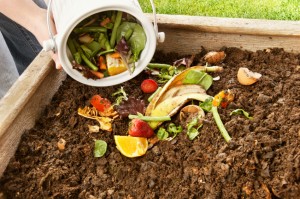Go Green In Your Kitchen: 8 Easy Eco-Friendly Steps
 Going green is one of the easiest ways to save money in your home (they don’t call it going green for nothing!) and as an added bonus, it’s also great for the environment and your community. One of the most popular and useful places in your home to “turn green” is your kitchen, aka one of the busiest and most bustling rooms in your house.
Going green is one of the easiest ways to save money in your home (they don’t call it going green for nothing!) and as an added bonus, it’s also great for the environment and your community. One of the most popular and useful places in your home to “turn green” is your kitchen, aka one of the busiest and most bustling rooms in your house.
Going green in your kitchen is simple with these 8 easy steps:
1. Recycle!
One of the simplest ways you can turn your kitchen green is to install a recycling system, since so many of the items we typically discard can actually be recycled. You can set up small receptacles in your kitchen for sorting various types of garbage and recyclables, such as paper/cardboard, plastic, glass, and aluminum cans or steel. (If you have a garage, you can save on room by putting the recyclable bins in there if your kitchen is too small.) Just make sure to do some general cleaning before you sort your recyclables (ie: rinse glasses, etc.).
Tip: Just a few of the plastic items you can recycle include: water bottles, salad dressing bottles, milk jugs, trash bags, disposable plates, and yogurt containers
2. Minimize Waste!
Using paper plates? Paper towels? Plastic bags? Think again! Substituting items such as these in your kitchen with reusable variations (which are more long-lasting) can greatly help minimize your impact on the environment, as well as can help you save money in the long run.
If you have a backyard or even a small garden/yard area outside your home, you should think about starting a compost bin. Everyday organic, biodegradable food scraps such a coffee grounds, egg shells, fruits, and veggies can be stored in a compost heap or compost bin in order to help fertilize the ground in your yard.
Tip: Avoid including dairy products and animal fats in your compost. For more information, The Environmental Protection Agency provides a comprehensive list of compost ingredient do’s and don’ts.
4. Minimize You Trash Eco-Impact!
Regardless of how carefully you sort your trash, not all items can be recycled or composted, but you can still see that your kitchen garbage remains eco-friendly. Since plastic bags don’t decompose ni landfills, you can use products like BioBags which offer an affordable biodegradable alternative to standard garbage bags. If you can’t use BioBags, try using bags created from recycled plastic. Finally, you might also consider using paper bags, which are naturally biodegradable and don’t leave as much as an environmental impact as plastic.
5. Conserve Energy!
You can conserve energy your appliances use by using Energy Star rated appliances, which can save 10-50% of the energy using by non-approved appliances. Plug small appliances such as your coffee maker and toaster in a single power strip and flip the switch off when not in use. (Anything that plugs in takes electricity, even when not in use.) Also, you can replace the standard light bulbs in your kitchen with fluorescent or CFL bulbs, which use three-quarters less electricity than incandescent lighting.
Similarly, you can install an inexpensive faucet aerator into your kitchen sink, which can help save on the loss of excess water when your rinse your dishes. And to save even more when washing dishes, make sure you only wash full loads of dishes in the dishwasher, and let them air dry when the cycle is done.
Whenever you can, opt for eco-friendly and natural cleaning products. Not only will this optimize your green kitchen, it will keep your family safe from harsh chemicals and help you support companies with environmentally-friendly goals. You can also make your own cleaning products using a variety of simple ingredients, such as white distilled vinegar, lemon juice, and baking soda.
Tip: For some natural and homemade cleaning product options, check out our earlier blog here for a handful of great and simple ideas!
7. Stop & Think Before You Shop!
Before you shop for food, take a minute to ask some questions: Where and how was this food grown? How did it get to the store? How is it packaged? The point is, you want to try to buy locally when possible. Typically your food at the grocery store can travel nearly 1,500 miles to reach you… and that’s just for one product, yikes! Just think of all the energy it takes to travel that distance. Also, try to buy organically when you can. Pesticides unfortunately have a great cost to the environment (and, as studies have shown, to your family’s health as well).
8. Remodel Green!
If you’re ready to give your kitchen a little facelift, there are a plethora of green options that can make a big impact environmentally. For instance, you can save money and help your community by using salvaged building materials for your job, or you can use recycled materials made of hemp, paper, glass, and aluminum. Also, keep an eye out for materials containing harmful, toxic formaldehyde, instead opting for solid wood or wheat-board. Similarly, check to see if your paint contains VOC (volatile organic compounds), which can be extremely harmful to your health.








